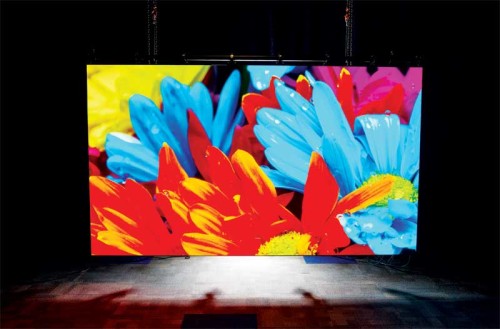LCDs and video walls
LED-backlit liquid crystal displays (LCDs) are among the most common types of digital displays. Generally, they conform to the native 16:9 aspect ratio format. They are relatively light, thin, efficient and long-lasting. By way of example, a 5.8-m (230-in.) LCD-based video wall may weigh about 454 kg (1,000 lb) without mounting equipment and run for 50,000 to 60,000 hours. LCDs in such a configuration are about 51 to 102 mm (2 to 4 in.) thick, use about 2,800 W, generate about 12,800 BTUs per hour and shine at 400 nits.
The maximum sizes of individual LCDs can hamper attempts to assemble ‘seamless’ video walls. Even so-called zero-bezel LCDs will still show image divisions in a video wall configuration.
Digital projectors
Digital video projection is generally the least expensive option for large-scale display and comes in two forms: rear projection, where images are projected onto the back side of a screen; and front projection, where—like in a movie theatre—the images are instead projected onto a surface from the front. Both forms require very low levels of ambient light to achieve clear image visibility, which is why high-profile projection mapping of buildings and other large outdoor surfaces takes place only at night.
Another primary restriction for video projections is the need for uninterrupted throwing distance, i.e. to keep the space clear between the projector and the projected surface. The size of the display space can help determine whether or not this will be realistic.

Different types of displays provide different colour gamuts.
Also, while this technology may be a relatively cheap way to create gigantic images, the costs of replacing projector bulbs need to be factored in, which could run into the thousands of dollars. Specialized labour may also be required to recalibrate and align multiple projectors for a given project.
Tile displays
Also known as mosaic displays, self-contained non-LCD tiles can be joined modularly to create larger display areas for a highly visually pleasing effect, but can also suffer from visible seams between units. They are twice as heavy as the equivalent LCD panels, due in part to their thickness of 254 mm (10 in.) or greater, which may not be suitable for many spaces.
In further comparison to LCDs, a 5.8-m (230-in.) mosaic will generate about 28,000 BTUs per hour, consume more than 8,000 W, shine at 600 nits and last for about 65,000 hours.
Advanced LED displays
LEDs are essentially small light bulbs, but more efficient and longer-lasting than incandescent bulbs. A higher-quality LED will provide approximately 50,000 to 100,000 hours of illumination, which is equivalent to about five to 11 years of typical use. This has helped today’s advanced LED displays establish a stronger foothold in the digital signage market.
Some LED displays are sufficiently light, thin and flexible to be formed into custom shapes for difficult installation spaces. Similar to LCD-based video walls, a 5.8-m (230-in.) LED-based video wall may weigh about 454 kg (1,000 lb) with a depth of 102 mm (4 in.), yet emit less than 2,000 BTUs per hour, consume only 2,100 W of power, achieve brightness
of 3,000 nits and, as mentioned, last up to 100,000 hours.
Such displays are suitable for both indoor and outdoor use where expected viewing distances are at least 1.5 to 3 m (5 to 10 ft).





